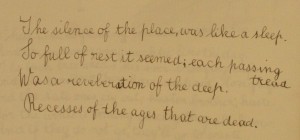Siegfried Sassoon’s Poems for ‘Mamsy’
The University Library is pleased to announce that descriptions of two new series of the Siegfried Sassoon papers are now available on Janus, the Cambridge archives catalogue: MS Add.9852/3, a series of his sporting notebooks, and MS Add.9852/6, a series of nine poetry notebooks.
While Siegfried Sassoon is best known as one of the greatest of the First World War poets, what is less well known is that he had in fact been developing his poetry from a very early age. Included in the collection is a notebook of poems written by Sassoon when just ten years old (MS Add.9852/6/1). The notebook was compiled as a gift for his mother’s birthday, and is lovingly dedicated ‘from Siegfried for Mamsy, March 28 1897’.
The poems are largely inspired by nature, with titles such as ‘Summer’, ‘The Four Winds’ and ‘To a Nightingale’, but they also include darker, more melancholic writings such as ‘The Solitary Reaper’, ‘Two Spirits’ and the ominously titled ‘Dreary and Uninhabited’. Transcribed in Sassoon’s neat hand, the poems are lavishly illustrated, and images can be viewed at http://www.lib.cam.ac.uk/exhibitions/Sassoon/Gladness.html.
The notebook also includes an early example of Sassoon’s prose writing – a short story entitled ‘The story of Peter, or incidents in the life of a cat’. In the story, Sassoon recounts the exploits of a fat and lazy housecat, described as being of respectable nature although somewhat inclined towards ‘vulgarity and theft’. A short but amusing tale, it was perhaps included due to his mother’s fondness for cats.
In his autobiographical work, ‘The Old Century’, Sassoon describes his early calling to what he called his ‘poetic vocation’. In his early years he looked to the great poets for inspiration and technique, so it is interesting that while the notebook is entitled ‘Poems by S.L. Sassoon’, the young Sassoon had in fact included extracts from poems by John Milton and Henry Wadsworth Longfellow, appearing to pass these off to his mother as his own work.
One ‘poem’, for example, entitled ‘The Silence of the Place’, was in fact a verse extracted from Longfellow’s ‘Monte Cassino, Terra di Lavoro (Birds of Passage, Flight the Fourth)’:
The silence of the place was like a sleep,
So full of rest it seemed; each passing tread
Was a reverberation from the deep
Recesses of the ages that are dead.
In the poem entitled ‘There on a Shore’ the young Sassoon more subtly interwove two lines adapted from Milton’s ‘Paradise Lost’ (Book 4, lines 598-99) into the middle of his own poem:
Now came still Evening on, and Twilight grey
Had in her sober livery all things clad
(Sassoon’s version reads “For now still eve had come, and twilight grey…”)
In ‘The Old Century’, Sassoon recalls that he had read these lines (from Milton) quoted in a book by Edmund Gosse, and had liked them so much he put them into his poem, wondering about their origin and whether his mother would notice!
Siegfried’s mother, Georgiana Theresa Thornycroft, was herself an artist of note, and recognised her son’s talent very early on. She encouraged him to work on his poetry and according to Sassoon, had a strong feeling he was destined to become a great poet.
Throughout his life, Siegfried kept up the habit of transcribing his poetry into notebooks, sometimes accompanied by illustrations. Examples of his later illustrations can be viewed at http://www.lib.cam.ac.uk/exhibitions/Sassoon/Gladness.html. Sassoon also kept commonplace books where he recorded extracts and quotations from various poets and writers. The notebook for ‘Mamsy’ therefore marks the beginning of what, for Sassoon, was to become a life-long practice.


Hi. You may be interested to know that I’ve just started up an SSF blog here: http://sassoonfellowship.blogspot.co.uk/